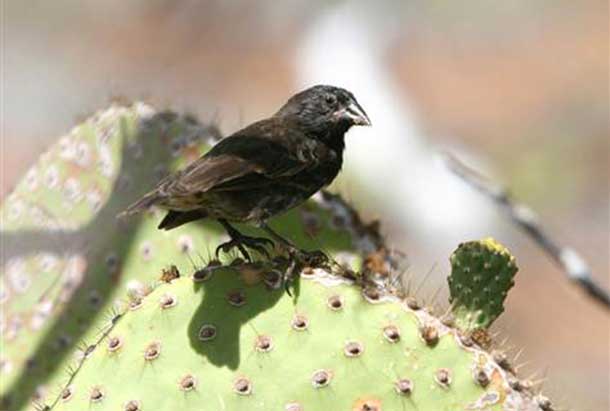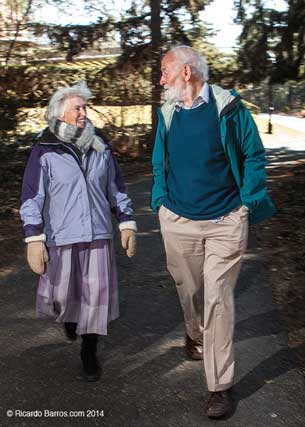
THUNDER BAY – Both Rosemary and Peter Grant leading researchers on the life cycle of Darwin finches on the Galapagos Islandwere Feature lecturers at Lakehead University last month.
Kudos to the nicely evolving Biology Department who diligently worked at crystallizing the outright uniqueness of this event. Known simply as ‘the Grants’ to the global world of scientists they have pursued their theme studying Darwin Finches over four decades. centred at the volcanic atoll of Daphne Major. An isolated outcrop part of the chain of 13 Galapagos landforms.
What they have accomplished is a remarkable biological Odyssey.
 When I inquired about the initial incentive that drew them to study there Peter reflected, quite animated with gusto, “Of course it was David Lambert Lack, a fellow Englishman, who was the ultimate pioneer long before. Now it’s ongoing insights being revealed, over time, focusing on these amazing finches Darwin described as birds capable of using a tool.”
When I inquired about the initial incentive that drew them to study there Peter reflected, quite animated with gusto, “Of course it was David Lambert Lack, a fellow Englishman, who was the ultimate pioneer long before. Now it’s ongoing insights being revealed, over time, focusing on these amazing finches Darwin described as birds capable of using a tool.”
It is well known a finch will pick a small stick or cactus needle while prodding for food. In their relentless work at Galapagos, a name once coined by Spanish sailors while watching the saddle back tortoises roaming and living there, the Grants have encountered two very incredible evolutionary cycles adding much to the original influential writings of Darwin. Darwin occupied the position of an onboard-naturalist on a ship called The Beagle under the command of Captain Fitzroy.
Having left England just after Christmas in 1831 Darwin made it back with his incredible synopsis time writing about revelations that have altered and impacted scientific societies forever. Darwin remarked, in his own autobiography, “It has been the most important event in my life and has determined my whole career.” He was reflecting at the time back at a place called Down House merely 16 miles from London.
This was after five years of ploughing through oceans in a wooden boat. Darwin was then safely away from the intolerant sea sickness he suffered through. He was satisfied by home.
Speaking of home the Grants have been in our homeland before. “Of course your city went by a different name then,” smiled Rosemary. To me, she is one with a theatrical smile reminiscent of what it may have been like in the presence of actress Katherine Hepburn. She was giggling, searching for the names. “Back then it was Port Arthur and Fort William,” I said. “So it was,” Rosemary acknowledged.
“We were travelling back in the sixties. Studying at the University of British Columbia. And to keep our Canadian connections on-going we later taught at McGill in Montreal. Since, we have had a number of Canadian students join us in conducting our field work.” We were standing to the side of the main lecture hall prior to their presentation. I showed them a book entitled Darwin at Galapagos which I had brought.
Peter held it and leafed through pages, with illustrations, and looked at the photos. “Well,” he said with a special favourable tone in his voice, “that is a book which I certainly couldn’t write any better. It’s by our daughter Thalia.” He was being humble of course. “Where did you discover that?”
Before I could answer, Rosemary chirped in, “Thalia presently lives in Vancouver. We pause to visit with her on our trips to Galapagos.” (The book was found in Duluth some years ago).
Rosemary added, “it really has been admirable seeing the numbers of students like Thalia that have been so keen assisting with all our tasks researching the finches. It would have been excruciatingly hard to accomplish all this research without valiant co-workers.” Thalia Grant’s description of Galapagos is memorable. In fact it’s an apt intro to this Bean Pot postcard I’m writing. She writes, “the islands of Galapagos are like scattered forgotten crumbs on a well swept floor. They are so totally isolated, arid, and barely visible on a world map. But insignificant they are not. Together they form a surprising world of their own.” And insignificant it has not been the scope and range of the Grants through the years.
Firstly, simply getting to Daphne Major is an adventure. They have religiously back-packed all their supplies of food, water, plus field equipment that begins with their initial ‘touchstone’ step in arriving there. For they have to make a high leap from their pontoon to the basalt formation of Daphne’s arid landscape. No small wakeup call to any one not fairly athletic. They land on a skimpy surface then hike up, with a human traction like mountain goats, on the face of geology only recently covered in shrubs and cactus. Then, “it’s a long and winding road,” to quote a Beatle’s song with twisting paths and not a place where long distance runners would be able to train. I press this point with Peter saying, “no four minute miler like Roger Bannister would run there?” He’s sharp and witty, at age 78, “that’s so true. Though I did run a five minute mile in my own youth.” He looks you dead right in the eye and grins at his recall. It’s a very distinct, and resilient, feature how trim and lithe both the Grants are. As well as being so authentically dedicated over 40 years. It has merited their esteem with evolutionary researchers on any continent today. But why the Darwin finches? And why the volcanic outcrop at Daphne Major? Simply because the finches are recognized as a living vertebrate version of evolution, echoing back eons in time, and miraculously consist of a species with a DNA makeup capable of an enlightening evolutionary pattern within a person’s lifetime.
Thus, the Grants have become part of a unique clan of human scientists. Having witnessed not one -but two – classic examples of this. Their research and analysis watching over generations of 13 different species of Darwin finches in programs cataloguing an estimated 18,000 birds. Meanwhile the gritty inhospitable outdoor laboratory at Daphne really does assure that these little aviators–still referred to as Charles Darwin’s finches, even though Darwin only spent 5 weeks in Galapagos–will thrive inside a uniquely enthralling, mystical setting and homeland at Galapagos.
The Grants put a focus on two really prime mover moments. Their initial amazement took place during a drought that became prolonged. Where daily temperatures hovered at suffocating 100 F extremes bordering the Equator where they were. To subsist in these conditions finch beaks became sharper and longer to mine the smallest of seeds often tucked away, virtually hidden, on the sunbaked ground. These were extremely tiny seeds sealed away in spots where a more stout beak, as a tool, could not enter. Daphne Major’s finch population shrank, resoundingly, by 85% in number. The other ‘breathtaking touch of evolutionary reality’ began to take shape during a time when El Niño brought in a deluge of rain with an abundance of greenery often covering the cactus with climbing vines. Immediate floods were in their sights. This reversed the trend. In reacting to their new environment the beak again become a life-tool. The finches gradually, obviously, modified their profiles once more. It proved evolutionary natural selection is a weekly, virtual daily, watch for Grants working inside their make shift tent camp on Daphne Major. With their dynamic zest in probing biological answers, besides their ongoing national geographic saga at Galapagos, the Grants rather sadly it seemed were on the threshold of saying farewell at this lecture. It felt as though such a welcoming audience would have stayed on much, much longer, for more. However, The Grants needed to get back to their lab locations and would be flying back to Princeton University in the U.S.A. and their work in New Jersey. Luckily, they had one more illustration in a gracious adieu. It was ‘the tree of life’ drawing, the only diagram in Charles Darwin’s Origin of Species book, by Darwin himself. With Darwin’s note, in ink, above the sketch: “I think.” Later followed by Darwin’s insightful expression, following a lifelong career in science, composed in his re-writing of the Beagle’s notebooks living at Down House. Literally thousands of entries, with specimens carted back to England, becoming the mother lode of his brilliant ideas, theories, and evolutionary realities he’d uncovered. And the Grants revealed Darwin’s
very personal entry at some point in his own understanding of it all:
“now… now…I do… believe.”
Ronn Hartviksen
